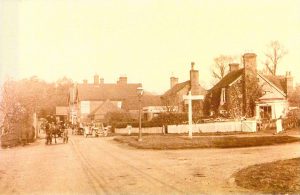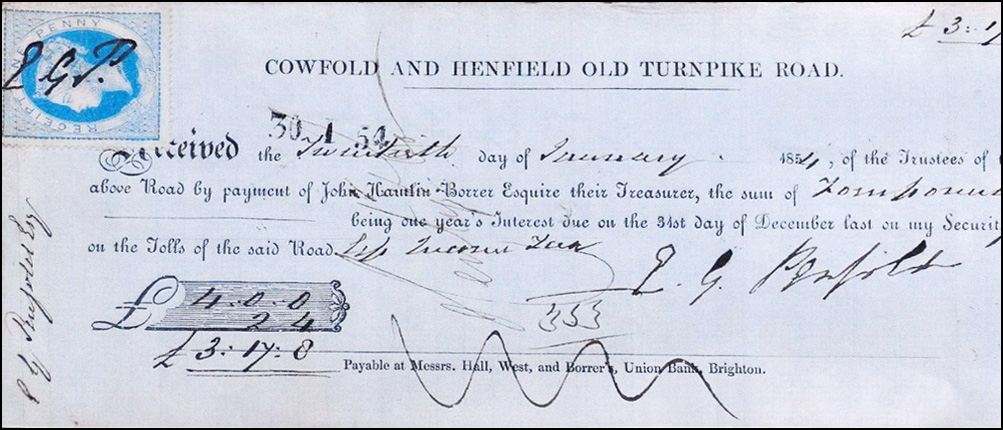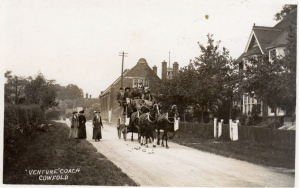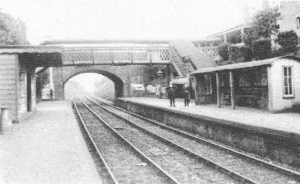
Horse drawn carriage and car in centre of village
Travelling around the Cowfold area up to the 18th and 19th centuries was difficult and hazardous because of the paucity and state of the roads and tracks, and was almost entirely reliant on walking and riding on horseback. In the 18th century, the need to improve inland transport and communication led to the development of turnpike roads and the establishment of turnpike trusts responsible for their maintenance, funded by levy charges on traffic; in time the trusts also became responsible for building new roads. A trust assumed responsibility for the road from Handcross to Henfield through Cowfold in 1771, and this was extended when the road from Horsham to the Crabtree was turnpiked in 1792. There was a tollgate on this road close to the entrance to Picts Lane and to the south there was another tollgate at Corner House in Shermanbury.

Turnpike Receipt
New roads included the route in 1824/25 that became the A272 and the roads connecting Ansty, Cowfold, West Grinstead and Billingshurst.

Venture Coach in Henfield Road
While the trusts were responsible for maintaining turnpiked roads, the parishes were responsible for the upkeep of parish roads. For Cowfold these responsibilities lay with the Vestry up until 1895 when it was replaced by the Parish Council, established under the Local Government Act 1894. Surveyors (or waywardens) were appointed from 1642; two each year except in 1704 when three were appointed. The Vestry minutes for 1844 to 1879 records that two to three men were employed on road repair during the summer and between five and eight men were employed between October and February. Road repair depended on local initiative, local labour and, in the first half of the 19th century, local sources of stone carted by ordinary farm wagons. The arrival of the railway branch line from Horsham through West Grinstead in 1861 meant that repair and surfacing material, in particular flint, could be accessed in bulk, in particular to cope with the increasing use of the roads by more and larger vehicles, such as powerful traction engines pulling large loads.

West Grinstead station
The 18th and 19th centuries saw vast changes in the traffic using country roads and the scale and ease of communications. Villages were no longer entirely self-contained communities separated by miles of neglected roadway. Consumable and other items could be transported in bulk to the village stores and homes. The railway branch line through West Grinstead and Partridge Green increased accessibility and spawned a number of other services such as that provided by a Mr Hale at Potters Green, who, by the end of the 19th century, was operating a number of small horse buses to connect Cowfold with the station at West Grinstead. Public stage coaches ran from Horsham southwards through Cowfold in the 19th century such as the Venture coach although this was more as a nostalgic reminder of the ‘old days’ than as a full public service. And of course motor cars became much more common from the end of the 19th century. At the end of the 19th century Cowfold had two garages, at Potters Green on Station Road, and at the White Lined House (now Farren Court) which was acquired by James Farren and his son. Following the closure of the Potters Green garage and up to 1930, when Fowlers built Bridge Garage on the Henfield Road, theirs was the only garage serving the village.
In the 1920s travelling out of the village by public transport was dependent on a “Southdown” double decker service to Horsham and Brighton and a single decker service to Billingshurst and Haywards Heath, and on the railway with West Grinstead station being the nearest stop some 3 miles to the west of Cowfold. That line was axed by the 1965 Beeching Review and was closed on 7 March 1966.
Transport today through and around the village is predominantly by car or other motor vehicle. Today the volume of traffic passing through the village has increased to an average of nearly 21,500 vehicles of all types on the A272, and a further 5,000 vehicles a day passing through on the A281.
